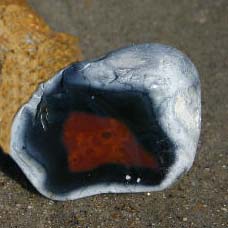Eine weltweit einmalige
geologische Besonderheit sind die braunroten Feuersteine, die auf
der Düne von Helgoland als Gerölle aufgelesen werden.
Während die
bekannten Feuersteine des Festlands in der Regel grau bis schwarz
gefärbt sind, ist der vor rund 88 Millionen Jahren im Mittelturon
der Oberkreide im Bereich der Düne von Helgoland entstandene Flint
schon auf erster Lagerstätte innen in verschiedenen Farbvarietäten
rot gefärbt. Der Feuerstein besteht aus dem sogenannten
“Skelettopal” unendlich vieler Kleinstorganismen, die
damals die Meere be völkerten. Bei der Zersetzung der organischen Anteile
dieser Tierchen wurde der “Skelettopal” löslich und
damit beweglich, floss in Hohlräume und in Gehäuse von Seeigeln,
Ammoniten und Muscheln, und härtete zu einer der stabilsten
Erhaltungsformen von Gesteinen mit einer Mohshärte von 7,5 aus. Wie
die Rotfärbung, hervorgerufen durch Anteile von Eisen³-Oxid, in die
Feuersteinknollen gelangte, ist ein ungelöstes Rätsel. Da die
Feuersteine in der Kreidezeit entstanden sind, haben sie in der
Regel eine weiße Kruste. Die Rinde kann aber auch schwarz, blaugrau
oder braun sein. Die Bruchstellen und ein gewisser Schimmer lassen
auf sein Inneres schließen. Das leuchtet in Schattierungen zwischen
rosa und burgund, umhüllt von einer braunen, schwarzen oder weißen
Schicht.
völkerten. Bei der Zersetzung der organischen Anteile
dieser Tierchen wurde der “Skelettopal” löslich und
damit beweglich, floss in Hohlräume und in Gehäuse von Seeigeln,
Ammoniten und Muscheln, und härtete zu einer der stabilsten
Erhaltungsformen von Gesteinen mit einer Mohshärte von 7,5 aus. Wie
die Rotfärbung, hervorgerufen durch Anteile von Eisen³-Oxid, in die
Feuersteinknollen gelangte, ist ein ungelöstes Rätsel. Da die
Feuersteine in der Kreidezeit entstanden sind, haben sie in der
Regel eine weiße Kruste. Die Rinde kann aber auch schwarz, blaugrau
oder braun sein. Die Bruchstellen und ein gewisser Schimmer lassen
auf sein Inneres schließen. Das leuchtet in Schattierungen zwischen
rosa und burgund, umhüllt von einer braunen, schwarzen oder weißen
Schicht.
Es gibt Berichte,
nach denen bei starken Fluten oder sogar Sturmfluten immer wieder
frisches Material an den Strand gespült wurde, wo vorher nur Sand
war. Es soll Tagesfunde mit bis zu 5 kg Feuerstein gegeben haben.
Funde auf der Düne sind aber heute mit Glück verbunden. Seit April
2009 werden die Gäste auf einem Naturlehrpfad über die
Besonderheiten der Düne informiert. Es wurden insgesamt 14 Tafeln
angefertigt, die an markanten Stellen die Themen der Düne
aufgreifen, wie Leben unter Wasser und in der Luft, Pflanzen und
Tiere auf der Düne, Geologie und Entstehung.
Nun zu den
Logbedingungen: Wir hätten gern ein Foto von dir mit GPS-Gerät vor
dem Leuchtturm auf der Düne und die Antworten auf die folgenden
Fragen:
Frage 1: In welcher Schicht der Oberkreide ist der rote Feuerstein
entstanden?
Frage 2: Welche Mohshärte haben Feuersteine in der
Regel?
Der Log darf mit
der Zusendung der Antwort an uns erfolgen. Sollte etwas falsch
beantwortet sein, melden wir uns.
Helgolander
flint
A worldwide unique
geologic specific feature are the puce flints which are picked up
on the dune by Helgoland as a stone.
While the known flints of the mainland are coloured as a rule grey
to black, resulted Flint already on the first bed is coloured
before about 88 million years in the middle Turonian of the upper
chalk in the area of the dune by Helgoland inside in different
colour varieties red. The flint passes of the so-called "skeletal
opal" endlessly a lot of microorganisms which populated at that
time the seas. With the decomposition of the organic shares of
these little animals the "skeletal opal" became dissolvable and
with it movable, flowed into hollow cavities and into case of sea
urchins, ammonites and mussels, and hardened to one of the most
stable preservation forms of rocks with a Mohs scale of 7.5. How
the red colouration, caused by shares of iron ³ oxide, in the flint
nodules reached, is an unsolved riddle. The flints have originated
in the chalk time, hence, they have as a rule a white crust.
However, the bark can be also black, bluish grey or brown. Break
places and a certain glow conclude by its inside. This shines in
shadings between pink and burgundy, coated by a brown, black or
white layer. There are reports according to which with strong
floods or even storm floods
were rinsed over and over again fresh material to the beach where
before only sand was. There should have been day findings with up
to 5 kg of flint. Today, however, findings on the dune are
connected with luck.
Since April, 2009 the guests on a nature trail are informed about
the specific features of the dune. A total of 14 boards which take
up the subjects of the dune at striking places like life under
water and in the air, plants and animals on the dune, geology and
origin were made.
Logging requirements: We would like a photo of you with your GPS in
front of the lighthouse on the dune and the answers to the
following questions:
Question 1: In which layer of the upper chalk the red flint has
originated?
Question 2: What is the Mohs scale of flints typically?
